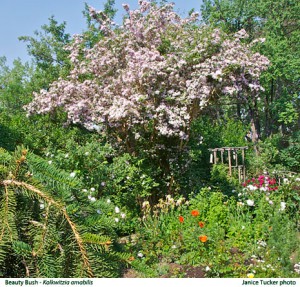 Scientific Name: Kolkwitzia amabilis
Scientific Name: Kolkwitzia amabilis
Plant Family: Caprifoliaceae – Honeysuckle
Common Name: Beauty Bush
Photos and Text By Janice Tucker
The Beauty Bush (Kolkwitzia amabilis) was a show-stopper at the June 5th SFBG Garden Tours. In a garden first begun in the 1930s and passed lovingly from owner to owner through the years, the Beauty Bush is positioned as the centerpiece in a setting of inviting paths meandering through grids of roses, irises, peonies, clematis and poppies. This elegant plant commanded the attention and admiration of all who strolled through the garden.
Reaching heights of eight to ten feet and top dimensions almost as wide, this beautiful member of the Honeysuckle family is aptly named. Its naturally vase-shaped growth habit has graceful, arching branches with one to three-inch dark green, opposite leaves, turning yellow to red in the autumn. In late spring and summer, dark pink buds appear in pairs to become one-inch soft pink, bell-shaped flowers. The oval fruit is a hairy capsule, measuring about a quarter inch in length.
The Beauty Bush prefers sun or light shade and well-drained soil. Once established, it requires moderate water and is hardy to USDA Zone 5. Birds, bees and butterflies are attracted to this relatively disease-free shrub. It should have ample room to spread and the temptation to prune it should be resisted since its natural shape is retained with very little assistance from the gardener. Older, thicker stems can occasionally be removed from the base during the dormant season. Propagation is by soft cuttings.
A native of Central China this deciduous large shrub or small tree was discovered twice. According to several sources, the first discovery was in the province of Shensi by Father Giuseppe Giraldi, a Franciscan monk and Italian botanist. In 1901, E. H. Wilson, on a plant collecting trip for Veitch Nurseries of Exeter, England, is credited with the second discovery of the Beauty Bush in the Hubei province of China. (Wilson was a respected plant collector who introduced about 2,000 Asian plant species to the West.) Nine years later the Beauty Bush flowered in England for the first time. In 1923 the Royal Horticultural Society bestowed its Award of Merit to the Beauty Bush.
The Beauty Bush was introduced to the eastern United States after World War I. During the 1930s and 1940s it became a garden favorite. With its graceful, fountain-like shape, it was often placed in prominent garden locations. And now, according to several local nurseries, it is making a comeback.
The genus, Kolkwitzia, is in honor of Richard Kolkwitz, a botany professor from Berlin. The species, amabilis, means “Beautiful, worthy of love” and is echoed in its common name, Beauty Bush.
Among the many striking plants set in lovely landscapes featured on the annual Santa Fe Botanical Garden’s tour of private gardens, the Beauty Bush was certainly one of the most memorable.


